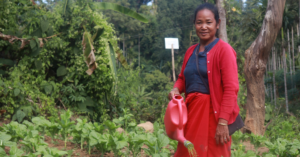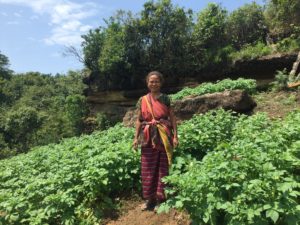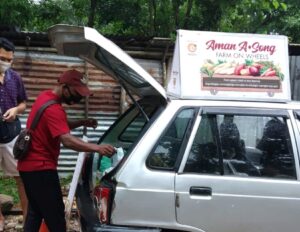A few weeks ago the author visited the Directorate of Agriculture with one of his colleagues from NESFAS (North East Slow Food and Agrobiodiversity Society). During a discussion, one of the senior staff of the Department remarked that the lack of proper registration of land holdings has been responsible for the farmers in the State missing financial benefits which would amount to a loss of thousands of crores. There is some truth in his assertion.
The much touted PM-KISAN scheme is meant to provide an income support of Rs. 6000/- per year. But in 2021 the number of farmers who benefitted from the Scheme was only 9000 (1% or less of the State’s farming population) which was down from the 70,236 (1% or less of the State’s farming population) who got the benefit the year before. Both numbers are very depressing. The reason for this is not the official reply about the beneficiaries’ inability in providing ‘correct and verified data’. It has to do with the 70% landless households in Meghalaya and the land tenure system which consist of community land/Commons (Ri Raid) alongside private land (Ri Kynti). While in the former the cultivator does not own any land, in the latter no papers can be produced because only usufructuary (use) rights are available not of ownership. Viewed in this manner, the Commons are a part of the problem why farmers in the State miss out on such benefits. The solution therefore, it follows, must lie in secure tenure rights under a private property regime.
The idea of the benefits of a private property regime is in fact very much deeply held in the mainstream policy circles. Whenever one talks of reform in any sector of the economy, it is about reducing communal ownership (state/public property) and introducing private ownership (privatization/disinvestment), case in point the ill-fated 2020 Farm Laws. The narrative of the inefficiency of the communal ownership model has become highly intensified in the post liberalization period, i.e., after 1991. This was done on the pretext of bringing efficiency and ensuring profitability, touted as the main weakness of the system. All this is consistent with the argument made by Garrett Hardin in his 1968 seminal work ‘Tragedy of the Commons’.
In the paper, Hardin gave the example of a pasture which is open to all herders, i.e., Commons. According to him, the arrangement initially works because of warfare, poaching and prevalence of diseases which limits the number of animals in the pasture. However, when social stability is achieved this arrangement fails and leads to an over-exploitation of resources. It happens because as a rational person, every herder tries to maximize his own benefit by adding more animals under the assumption that the benefit of increasing the herd will accrue entirely to him but the negative effects will be lesser since it will be shared by all. Since every herder follows the logic of a rational man, the entire pasture becomes degraded, hence, the tragedy of the commons. On surface the argument appears logical but does it stand to empirical scrutiny? What happens to those groups whose land tenure system is based on the Commons, case in point the indigenous communities of which the Khasis are an example. Did the Commons lead to a degradation of the environment and loss of resources?
In 2021, the Food and Agriculture Organisaton of the UN (FAO) brought out the report “The White/Wiphala Paper on Indigenous Peoples’ food systems”. This document was the result of collective work by Indigenous Peoples’ representatives and experts, scientists, researchers, and UN staff with the author being one of the contributors. The initiative was coordinated by the Global-Hub on Indigenous Peoples’ Food Systems and edited by a Technical Editorial Committee. A very important finding from the paper is that while indigenous peoples occupy over a quarter of the world’s land, their territories holds 80 percent of the world’s terrestrial biodiversity. This is true of India as well. The Ministry of Tribal Affairs in its 2006 report ‘National Tribal Policy’ has also stated that while the tribal (i.e., indigenous) population makes up less than 9% of the country’s population, they are found to be living in areas which are very rich in natural resources. All the four biodiversity hotspots found in the Indian sub-continent, viz., Western Ghats and Sri Lanka, Indo-Burma, Himalayas and the Sundaland (which includes Andaman and Nicobar Islands) are home to many tribal groups. But according to the logic of the tragedy of commons, indigenous territories should instead be characterized by scarred and degraded landscapes, the result of centuries of exploitation due to the land tenure system based on community land ownership or com Commons mons. How did the reverse happen? The answer might actually be found in the way cultivation practices of broom grass (Thysanolaena maxima) in Meghalaya differ in community land as against that in private land.
Broom grass is a very important cash crop for the farmers in Meghalaya. Its importance is highlighted by the fact that it is one of the crops whose price is being regulated by the State Government. It was remarked by a senior scientist, with whom the author was working many years ago, that cultivation of broom grass is one of the most important factors in thatch houses transforming into pucca houses in rural areas of the State. However, at the same time, the crop is blamed for causing severe land degradation. Anecdotal evidence abounds on how villages growing broom grass eventually had to be abandoned because of the drying of the water sources. Absent in all these discussions is whether such villages were growing broom grass in community land or private land.
Just like many in the State, farmers in Nongtraw, a village in the Khatarshnong Laitkroh C&RD Block, also grow broom grass, both in community land as well as private land. While in the private lands, broom grass is grown continuously for many years, in the community land it is grown only for three years. With shifting cultivation being the main farming system in the village, broom grass follows after the food plants have been harvested after a year of cultivation. Although broom grass remains even after three years, the community does not allow any more harvesting but mandates the land be left fallow. After a period of 12-15 years, natural vegetation returns overwhelming the broom grass. The land is cleared and the cycle begins again. Done in this way, livelihood is assured but environmental degradation is avoided. This is because the community makes decisions based on collective good and not individual needs.
Garrett Hardin’s thesis of ‘Tragedy of the commons’ has been criticized for lacking historical and empirical grounding. But even the theoretical basis is also highly shaky. According to him, while the private property regime is one of the solutions to prevent the indiscriminate exploitation of resources, he does admit that it is an unjust system but disturbingly “injustice is preferable to total ruin” (p.1244). In another place, he questions whether the solution might even work through the example of an owner of the factory on the bank of a stream who under the private property regime has difficulty in seeing why it is not his natural right to muddy waters flowing past his door. The thesis lacks both theoretical and empirical basis. But it is what drives the narrative of property regime discussion in the mainstream, i.e., individual patta, privatization of all economic sectors which includes agriculture, etc. The outcomes of accepting the idea are the current ecological crises and growing inequality globally.
If Meghalaya wants to improve the lot of the citizens in the State (especially the farmers), it will have to confront the issue of landlessness which is growing like a cancer and realize that it is linked to the growth of erosion of Commons. This is already having ecological (coal mining) and social (rising inequality) problems in the State. The solution cannot rest on expansion of the private property regime (something which caused the problem cannot be the solution). It instead lies in coming together, state and civil society, to strengthen the tradition of Commons (i.e., community lands) of the indigenous peoples of the State.



